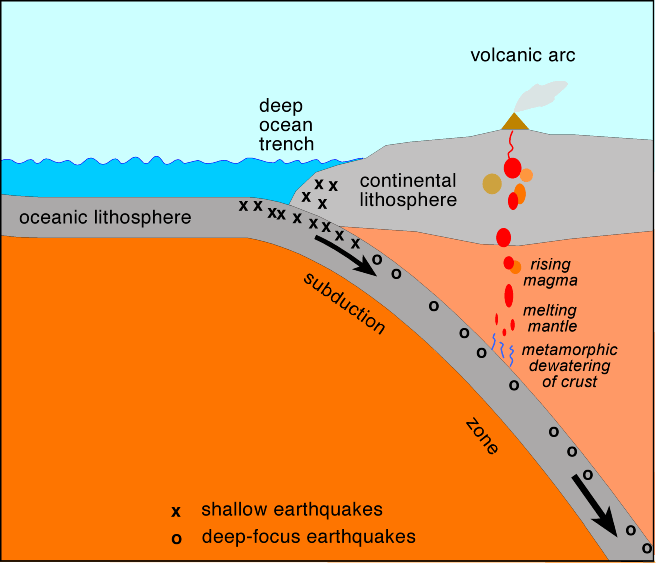Where two tectonic plates converge, if one or both of the plates is oceanic lithosphere, a subduction zone will form. An oceanic plate will sink back into the mantle. Remember, oceanic plates are formed from mantle material at midocean ridges. Young oceanic lithosphere is hot and buoyant (low density) when it forms at a midocean ridge. But as it spreads away from the ridge and cools and contracts (becomse denser) it is able to sink into the hotter underlying mantle. There is a deep ocean trench where the oceanic plate bends downward.
Volcanic Arcs: The basaltic ocean crust contains hydrous minerals like amphiboles, some of which formed by hydrothermal alteration as seawater seeped through hot, fractured, young ocean crust at the midocean ridge. As the ocean crust sinks deeper into the mantle the pressure increases (the temperature of the ocean crust rocks increases more slowly because rocks are poor conductors of heat). At depths of around 100 km beneath the surface, the pressure is great enough for the hydrous minerals to undergo metamorphism. The resulting minerals are denser and they don't contain the bonded water. This metamorphic dewatering process liberates water from the descending crust. The water gradually seeps upward into the overlying wedge of hot mantle. The addition of water to the already hot mantle rocks lowers their melting temperature resulting in partial melting of ultramafic mantle rocks to yield mafic magma. Melting aided by the addition of water or other fluid is called flux melting. It is somewhat more complicated than this, but metamorphic dewatering of suducting crust and flux melting of the mantle wedge appears to account for most of the magma at subduction zones.
Magma formed above a subducting plate slowly rise into the overriding crust and finally to the surface forming a volcanic arc, a chain of active volcanoes which parallels the deep ocean trench. Beneath the active volcanic arc lie intrusive igneous rocks formed from magma that didn't make it all the way to the surface before crystallizing. The volcanic arcs may be volcanic island arcs(e.g., Aleutians, Mariannas), where one oceanic plate subducts beneath another oceanic plate, or continental volcanic arcs (e.g., Andes, Cascades), where oceanic plates subduct under a continental plate. The most abundant igneous rock formed at volcanic arcs is andesite (or intrusive diorite), though volcanic arc rocks may range in composition from basalt to rhyolite (mafic to felsic)
